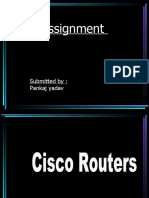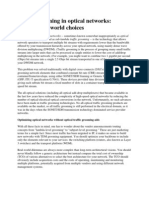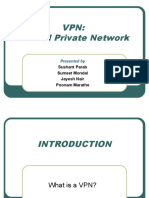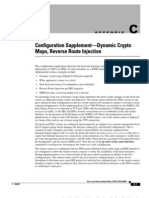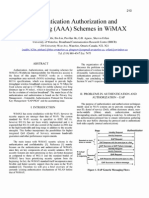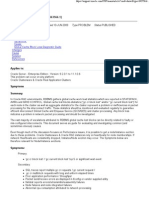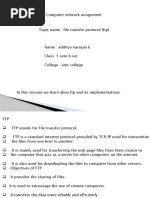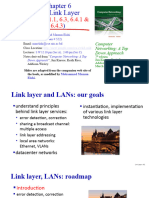Configuring and Testing: CCNA Exploration Semester 1 - Chapter 11
Uploaded by
palogjohnjrConfiguring and Testing: CCNA Exploration Semester 1 - Chapter 11
Uploaded by
palogjohnjrConfiguring and testing
CCNA Exploration Semester 1 – Chapter 11
© 2006 Cisco Systems, Inc. All rights reserved. Cisco Public 1
Topics
The Internetwork Operating System (IOS).
Devices that have the IOS embedded.
IOS commands available to a device.
IOS modes of operation.
Basic IOS commands.
Basic show commands.
Configuration files
© 2006 Cisco Systems, Inc. All rights reserved. Cisco Public 2
Internetwork Operating System
Most Cisco devices use the Cisco IOS.
Details vary with the device and feature set.
Normal access through a command line.
Stored in flash memory and can be upgraded.
Usually copied into RAM when the device is powered
on, and run from RAM.
© 2006 Cisco Systems, Inc. All rights reserved. Cisco Public 3
Access to the interface
Console port via serial connection
Initial configuration
Disaster recovery
When network access has failed
Password recovery
As well as general management
Console access does not require a password.
Configure a password. Lock the door.
© 2006 Cisco Systems, Inc. All rights reserved. Cisco Public 4
Telnet, SSH, Aux
Later management can be via Telnet
There must be an IP address on the port
A password must be configured
Secure shell gives better security
AUX port can be used locally or via modem but by
default does not show error messages
© 2006 Cisco Systems, Inc. All rights reserved. Cisco Public 5
Configuration files
Hold the commands that have been configured on the
router to customise it.
Running configuration in RAM holds commands that
are in current use
Startup configuration in NVRAM holds saved
commands. These are kept when the power is off and
usually copied back into RAM when the router is re-
started.
© 2006 Cisco Systems, Inc. All rights reserved. Cisco Public 6
Router storage areas
ROM Flash
Permanent Keeps contents
Holds POST, boot instructions, Holds IOS image
basic IOS
RAM
NVRAM
Volatile
Keeps contents
Holds runnning config, tables,
Holds startup configuration file
queues etc
© 2006 Cisco Systems, Inc. All rights reserved. Cisco Public 7
Router IOS modes
User EXEC mode
enable disable
+ password
Privileged EXEC mode
Configure terminal Exit or Ctrl+z
Global Configuration mode
Various commands Exit End
Specific Configuration modes
© 2006 Cisco Systems, Inc. All rights reserved. Cisco Public 8
Router prompts
User EXEC mode Router>
Privileged EXEC mode Router#
Global Configuration mode Router(config)#
Router(config-if)#
Specific Configuration modes and others
© 2006 Cisco Systems, Inc. All rights reserved. Cisco Public 9
EXEC modes
You log in to User EXEC mode
Router>
You can give basic monitoring commands but cannot
change the configuration
Enter enable to go to Privileged EXEC mode
Router#
Password may be used for security
You can give more commands and can go to configuration
modes
© 2006 Cisco Systems, Inc. All rights reserved. Cisco Public 10
Configuration modes
Start in privileged EXEC mode and enter the configure
terminal (config t) command
Router# config t
Router(config)#
The prompt changes
This is global configuration mode
Additional commands take you to interface
configuration, router configuration etc.
© 2006 Cisco Systems, Inc. All rights reserved. Cisco Public 11
Leaving configuration modes
From interface configuration mode there are several
ways of getting to privileged EXEC
Router(config-if)# exit
Router(config)# exit
Router#
Router(config-if)# end
Router#
Router(config-if)# Ctrl+z
Router#
© 2006 Cisco Systems, Inc. All rights reserved. Cisco Public 12
Command Structure
Followed by <Enter>
© 2006 Cisco Systems, Inc. All rights reserved. Cisco Public 13
? To get help
? Gives a list of commands available from the current
prompt.
Command followed by space then ? Gives a list of
keywords or arguments that can be used.
Start of command followed by ? with no space shows
how the word can be continued.
© 2006 Cisco Systems, Inc. All rights reserved. Cisco Public 14
Shortened commands
Router#show running-config
Router#show run
Router#sh ru
It needs enough letters of each word to be
unambiguous. (Tab key shows whole word)
Router#s ru
% Ambiguous command: ‘s’
© 2006 Cisco Systems, Inc. All rights reserved. Cisco Public 15
Other error messages
Switch#clock set
% Incomplete command
Switch#clock set 19:50:00 25 6
% Invalid input detected at ‘^’ marker
^
Router#show runming-config
% Invalid input detected at ‘^’ marker
^
© 2006 Cisco Systems, Inc. All rights reserved. Cisco Public 16
Keyboard shortcuts
Tab completes a partial command
Backspace erases to left of cursor
Ctrl+D erases at cursor (Delete does not)
Ctrl+Z returns from any config mode to privileged
exec mode
Ctrl+C leave Setup mode
© 2006 Cisco Systems, Inc. All rights reserved. Cisco Public 17
Show commands
Show ? To get a list
Many different show commands to give information
about every aspect of the router and its operation
We use some of the most common.
© 2006 Cisco Systems, Inc. All rights reserved. Cisco Public 18
General show commands
Show running-config shows the configuration file from
RAM
Show startup-config shows the saved configuration
file from NVRAM
Show version gives information about the IOS and the
router itself. It shows the configuration register, which
controls how the router starts up.
© 2006 Cisco Systems, Inc. All rights reserved. Cisco Public 19
Show interfaces
Gives statistics for all interfaces
In particular, says if the interface is up and if the
protocol is up – important in troubleshooting.
Show interfaces serial 0/0 to show one selected
interface
You can shorten to show int s 0/0
Show ip interfaces gives IP statistics
© 2006 Cisco Systems, Inc. All rights reserved. Cisco Public 20
Save configuration
Router#copy running-config startup-config
Router#copy run start (shortened)
Router#wr (Old fashioned, short for write, but it works and
is safe.)
Beware! A typing error in the copy command can delete the
operating system. If you get an odd message about Flash –
hands off – call for help.
© 2006 Cisco Systems, Inc. All rights reserved. Cisco Public 21
Hostname
Router>enable
Router#config t
Router(config)#hostname Paris
Paris(config)#
Configure a suitable hostname so that you know which
router you are managing and so that you can identify it
in network documentation.
© 2006 Cisco Systems, Inc. All rights reserved. Cisco Public 22
Console password
Paris(config)#line con 0
Paris(config-line)#password cisco
Paris(config-line)#login
Paris(config-line)#exit
Restricts access via the console
Use cisco as the password in labs.
Use a proper strong password on production networks
© 2006 Cisco Systems, Inc. All rights reserved. Cisco Public 23
Vty password for Telnet
Paris(config)#line vty 0 4
Paris(config-line)#password cisco
Paris(config-line)#login
Paris(config-line)#exit
Allows and restricts access via 5 vty lines
Use cisco as the password in labs.
Use a proper strong, different password on production
networks
© 2006 Cisco Systems, Inc. All rights reserved. Cisco Public 24
Enable and enable secret
Paris(config)#enable secret class
The password class is needed when you type enable to
enter privileged exec mode
This password is encrypted
Paris(config)#enable password cisco
Not encrypted, used on older routers
If you configure both, then only the enable secret is used.
© 2006 Cisco Systems, Inc. All rights reserved. Cisco Public 25
Message of the day
Paris(config)#banner motd # No unauthorised
access #
# is a delimiter to show where the message starts and
ends.
Any character can be used as long as it does not
appear in the message.
The message should make it clear that unauthorised
access is forbidden.
© 2006 Cisco Systems, Inc. All rights reserved. Cisco Public 26
Reload
Shuts down the router and then starts it again.
If the configuration has changed then you are prompted
to save it.
The running configuration in RAM is lost.
The startup configuration from NVRAM is (usually)
loaded into RAM on startup.
© 2006 Cisco Systems, Inc. All rights reserved. Cisco Public 27
Back up to TFTP server
Start TFTP server software on host
Paris#copy running-config tftp
Remote host []? 172.16.1.1
Name of configuration file to write [Paris-config]?
Paris12Oct07
Write file Paris12Oct07 to 172.16.1.1? [confirm] y
Writing Paris12Oct07 ! ! ! ! ! ! [OK]
© 2006 Cisco Systems, Inc. All rights reserved. Cisco Public 28
Back up as text file
Start text capture
Name file
show run
Stop text capture
Open saved file and
© 2006 Cisco Systems, Inc. All rights reserved. Cisco Public 29
TeraTerm text file
TeraTerm is an open source Telnet client.
It can also act as a SSH client
It can capture text and save it as a file.
© 2006 Cisco Systems, Inc. All rights reserved. Cisco Public 30
Erase startup configuration
Paris#erase NVRAM:startup-config
Paris#erase startup-config
Paris#erase start
If you reload, then the router starts up with the default
configuration. No passwords, no IP addresses etc.
Caution if you get this command wrong then you could
erase something else, e.g. IOS
© 2006 Cisco Systems, Inc. All rights reserved. Cisco Public 31
Restore file from TFTP server
Router#copy tftp running-config
You will be prompted for IP address and file name.
Configuration is copied into RAM and takes effect at
once.
Save to NVRAM.
© 2006 Cisco Systems, Inc. All rights reserved. Cisco Public 32
Restore text file
Go to global configuration
mode
Hyperterminal Transfer
menu
Send text file…
Or
Copy text from text file
“Paste to host” into Hyperterminal session
© 2006 Cisco Systems, Inc. All rights reserved. Cisco Public 33
Configure a router interface
Paris(config)#interface FastEthernet 0/0
Paris(config-if)#ip address 172.16.1.1 255.255.0.0
Paris(config-if)#no shutdown
Paris(config-if)#exit
Interface names vary, depending on whether the router
is modular and on the bandwidth.
E.g. interface Ethernet 0 on an older router
© 2006 Cisco Systems, Inc. All rights reserved. Cisco Public 34
Configure a router interface
Paris(config)#interface serial 0/0
Paris(config-if)#ip address 192.168.4.1 255.255.255.0
(Paris(config-if)#clock rate 64000)
Paris(config-if)#no shutdown
Paris(config-if)#exit DCE only
© 2006 Cisco Systems, Inc. All rights reserved. Cisco Public 35
Description
Paris(config)#interface fa0/0
Paris(config-if)#description Connects to Paris central
switch
Can include circuit and contact information
Not needed for the operation of the router
Valuable for documentation as it is included in the
configuration listing
© 2006 Cisco Systems, Inc. All rights reserved. Cisco Public 36
Switch interfaces
Switch physical interfaces do not have IP addresses
They are active by default and do not need the no
shutdown command.
It can be useful to give them a description.
© 2006 Cisco Systems, Inc. All rights reserved. Cisco Public 37
Switch IP address
The switch IP address goes on a virtual interface, not a
real one, normally VLAN1.
SwA(config)#interface VLAN1
SwA(config-if)#ip address 172.16.255.1 255.255.0.0
SwA(config-if)#no shutdown
SwA(config-if)#exit
© 2006 Cisco Systems, Inc. All rights reserved. Cisco Public 38
Switch default gateway
SwA(config)#ip default gateway 172.16.255.254
Just like a workstation, a switch needs a default
gateway if it exchanges messages with devices on a
different network.
The default gateway is the address of the local router.
© 2006 Cisco Systems, Inc. All rights reserved. Cisco Public 39
Interface – show commands
show interfaces states whether up or down, gives
some protocol information and statistics about interface
use.
show ip interface gives IP addresses and much more.
show ip interface brief gives summary of IP
addresses and whether up/down. Very useful
command.
© 2006 Cisco Systems, Inc. All rights reserved. Cisco Public 40
Up or down
Interface status: Layer 1
Up
Down
Administratively down (no shutdown to bring up)
Protocol: Layer 2
Up
Down (no keepalive signal received)
© 2006 Cisco Systems, Inc. All rights reserved. Cisco Public 41
Ping – step by step
Ping 127.0.0.1 (loopback, is TCP/IP OK?)
Ping own IP address (are NIC hardware and software all
right? Is IP address bound?)
Ping local hosts (checks own configuration and that of
others)
Ping gateway
Ping other intermediate routers
Ping hosts on remote networks
© 2006 Cisco Systems, Inc. All rights reserved. Cisco Public 42
Network baseline
Measure and record performance
At different times
Under different conditions
Repeatedly over a period of time
Build up a record of network performance
Useful in troubleshooting and optimising the network
Helps predict future problems
Helps planning for change
© 2006 Cisco Systems, Inc. All rights reserved. Cisco Public 43
Find out about nodes
Ping – used from workstation, router or switch – shows
if destination can be reached
Traceroute – shows hops along the path
Arp -a on workstation – shows list of MAC and IP
addresses
show mac-address-table on switch – shows list of MAC
addresses and switch ports
© 2006 Cisco Systems, Inc. All rights reserved. Cisco Public 44
Summary
Hierarchical Design model addresses performance,
scalability, maintainability & manageability issues.
Traffic Analysis is used to monitor network
performance.
Hierarchical Design Model is composed of 3 layers:
Access
Distribution
Core
Switches selected for each layer must meet the needs
of each hierarchical layer as well as the needs of the
business.
© 2006 Cisco Systems, Inc. All rights reserved. Cisco Public 45
Labs & Activities
Type Detail
Lab 11.1.6 Mandatory*
Lab 11.1.7 Mandatory
Lab 11.2.1 Mandatory
Lab 11.2.2 Review carefully
Lab 11..2.3 Mandatory
* If no previous Packet Tracer experience, else strongly recommended
© 2006 Cisco Systems, Inc. All rights reserved. Cisco Public 46
© 2006 Cisco Systems, Inc. All rights reserved. Cisco Public 47
You might also like
- CCNA 1 Router & Switch Configuration Commands82% (28)CCNA 1 Router & Switch Configuration Commands2 pages
- Cisco CCNA Command Guide: An Introductory Guide for CCNA & Computer Networking Beginners: Computer Networking, #3From EverandCisco CCNA Command Guide: An Introductory Guide for CCNA & Computer Networking Beginners: Computer Networking, #34.5/5 (2)
- Jana 2 Server: Documentation by Lukas I.M. VanaNo ratings yetJana 2 Server: Documentation by Lukas I.M. Vana12 pages
- Configuring and Testing: CCNA Exploration Semester 1 - Chapter 11No ratings yetConfiguring and Testing: CCNA Exploration Semester 1 - Chapter 1147 pages
- 05_ITNv51_InstructorPPT_CH2-mod-w-videoNo ratings yet05_ITNv51_InstructorPPT_CH2-mod-w-video62 pages
- Configure A Network Operating System: Introduction To Networks v5.1No ratings yetConfigure A Network Operating System: Introduction To Networks v5.154 pages
- CCNA1_Mod2_Mod10_Basic_Switch_and_Router_ConfigurationNo ratings yetCCNA1_Mod2_Mod10_Basic_Switch_and_Router_Configuration36 pages
- Cisco Router Is A Device That Switches Data Packets Between Two Different NetworksNo ratings yetCisco Router Is A Device That Switches Data Packets Between Two Different Networks11 pages
- Configure A Network Operating System: Introduction To Networks v5.1No ratings yetConfigure A Network Operating System: Introduction To Networks v5.155 pages
- Introduction To Cisco Ios: Prepared By, Prof - Dhanalakshmi IT Dept, ScetNo ratings yetIntroduction To Cisco Ios: Prepared By, Prof - Dhanalakshmi IT Dept, Scet90 pages
- List of Router Configuration Commands: Router (User Exec Mode) ToNo ratings yetList of Router Configuration Commands: Router (User Exec Mode) To6 pages
- WXES2106 Network Technology Semester 1 2004/2005: RoutersNo ratings yetWXES2106 Network Technology Semester 1 2004/2005: Routers34 pages
- Router Components RAM: Boot Field MeaningNo ratings yetRouter Components RAM: Boot Field Meaning13 pages
- Managing A Cisco Internetwork: Sonia Hanif Roll NoNo ratings yetManaging A Cisco Internetwork: Sonia Hanif Roll No32 pages
- IOS Tips and Tricks: Expert Reference Series of White PapersNo ratings yetIOS Tips and Tricks: Expert Reference Series of White Papers11 pages
- LAB4 Introduction to Router Configuration (1)No ratings yetLAB4 Introduction to Router Configuration (1)8 pages
- Router Components: Khawar Butt Ccie # 12353 (R/S, Security, SP, DC, Voice, Storage & Ccde)No ratings yetRouter Components: Khawar Butt Ccie # 12353 (R/S, Security, SP, DC, Voice, Storage & Ccde)11 pages
- Seminar On Routers & Ip Addrresing: Made By:-Varun DeshlahraNo ratings yetSeminar On Routers & Ip Addrresing: Made By:-Varun Deshlahra48 pages
- Mode Prompt Command To Enter Command To ExitNo ratings yetMode Prompt Command To Enter Command To Exit8 pages
- Chapter 7 - Security of Network DevicesNo ratings yetChapter 7 - Security of Network Devices52 pages
- Router Configuration With SYNTAX (Updated)No ratings yetRouter Configuration With SYNTAX (Updated)9 pages
- Cisco IOS Basic Skills: Configuring The Router From A PCNo ratings yetCisco IOS Basic Skills: Configuring The Router From A PC8 pages
- Sybex CCNA 640-802: Chapter 7: Managing A Cisco InternetworkNo ratings yetSybex CCNA 640-802: Chapter 7: Managing A Cisco Internetwork33 pages
- Lab 5.2.6a Password Recovery Procedures: Background/PreparationNo ratings yetLab 5.2.6a Password Recovery Procedures: Background/Preparation5 pages
- Chapter 2: Configure A Network Operating System: CCNA Routing and Switching Introduction To Networks v6.0No ratings yetChapter 2: Configure A Network Operating System: CCNA Routing and Switching Introduction To Networks v6.047 pages
- CA - Ex - S1M11 - Configuring and Testing Your Network100% (1)CA - Ex - S1M11 - Configuring and Testing Your Network67 pages
- OSI Data Link Layer: CCNA Exploration Semester 1No ratings yetOSI Data Link Layer: CCNA Exploration Semester 120 pages
- OSI Transport Layer: CCNA Exploration Semester 1 - Chapter 4No ratings yetOSI Transport Layer: CCNA Exploration Semester 1 - Chapter 425 pages
- Application Layer Functionality and Protocols: Network Fundamentals - Chapter 3No ratings yetApplication Layer Functionality and Protocols: Network Fundamentals - Chapter 317 pages
- Living in A Network Centric World: Introduction of Computer Networks - Lesson 1No ratings yetLiving in A Network Centric World: Introduction of Computer Networks - Lesson 136 pages
- Set-Up Computer Networks Setting-Up Computer NetworksNo ratings yetSet-Up Computer Networks Setting-Up Computer Networks10 pages
- Thesis Capstone Project Guidelines 2014 v1 2 PDFNo ratings yetThesis Capstone Project Guidelines 2014 v1 2 PDF34 pages
- Quick Test 3 IP Addressing & Subnetting - AnswersNo ratings yetQuick Test 3 IP Addressing & Subnetting - Answers7 pages
- 844E Gigacenter - Etsi: Product DatasheetNo ratings yet844E Gigacenter - Etsi: Product Datasheet4 pages
- VPN: Virtual Private Network: Sushant Parab Sumeet Mondal Jayesh Nair Poonam MaratheNo ratings yetVPN: Virtual Private Network: Sushant Parab Sumeet Mondal Jayesh Nair Poonam Marathe31 pages
- OpenStage HFA V3R0.23.3 Release Notes V3.4 Extern100% (1)OpenStage HFA V3R0.23.3 Release Notes V3.4 Extern18 pages
- Configuration Supplement-Dynamic Crypto Maps, Reverse Route InjectionNo ratings yetConfiguration Supplement-Dynamic Crypto Maps, Reverse Route Injection8 pages
- Authentication Authorization and Accounting (AAA) Schemes in WiMAXNo ratings yetAuthentication Authorization and Accounting (AAA) Schemes in WiMAX6 pages
- 2.7.6 Packet Tracer - Implement Basic ConnectivityNo ratings yet2.7.6 Packet Tracer - Implement Basic Connectivity7 pages
- Hughesnet ht2000w Satellite Modem User Guide 1041264-0001 ANo ratings yetHughesnet ht2000w Satellite Modem User Guide 1041264-0001 A53 pages
- Catalyst 3560 Software Con Guration Guide, Release 12.2 (52) SENo ratings yetCatalyst 3560 Software Con Guration Guide, Release 12.2 (52) SE64 pages




















































